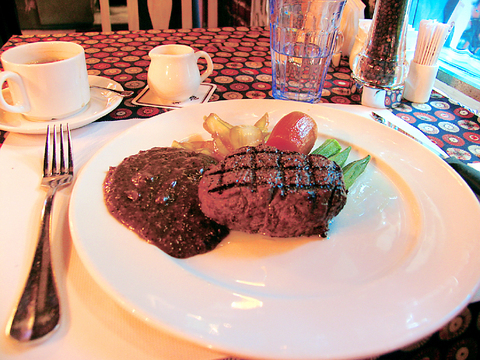If you've passed by any of Cafe Onion's four locations around the dinner hour, you've likely seen a gaggle of gawkers outside looking through the large windows at the lucky ones already inside eating. The gawkers aren't simply waiting, they're hovering at the door like a choir of drooling carolers. Curious to know if it was worth the wait, I joined this group outside the Onion's Fuxing store this past week. Suffice to say, I'll be joining it again.
Onion is a steak house and the line outside is kept in rapt anticipation because of the aroma. It's the smell of a well-seasoned grill hard at work and each time the door is opened, the smell rushes onto the street, stopping traffic and pulling more people into the queue.

PHOTO CREDIT: DAVID MOMPHARD, TAIPEI TIMES
The inside is made up to look like the boarding house saloons of the young American West and, combined with the smell, helps build your anticipation. The letdown comes -- however briefly -- when you're handed the menu. It's the kind that carries an unappetizing picture of each item with its name and a price below. It's a letdown because it hardly looks like what you imagined you've been smelling all along.
What's more, at my 7pm visit, the menu I was handed had two steaks -- the top sirloin and their New York strip -- taped over with a sign that read "sold out." But it wasn't newly taped over. Rather, it looked as though they'd stopped serving these cuts a long time ago and were lying on their menu.
Turns out it wasn't a lie.
They sell out of the sirloin and New York every night, my waiter explained. "So we have two sets of menus and hand out these when those steaks are gone. It's more efficient that way."
I understood what she meant about efficiency after I'd ordered a filet mignon set meal. Each course came promptly after finishing the previous item and was freshly prepared. The exception was the French onion soup, which seemed to have withered under a heat lamp. The filet itself, though, was excellent. It came with steamed okra and a delicious caramelized sweet potato that could have passed as dessert.
It's Onion's steaks that cause the queue out front. They're also the reason I'll be returning (though I may arrive earlier to see why that sirloin and New York strip always sell out).

Oct. 27 to Nov. 2 Over a breakfast of soymilk and fried dough costing less than NT$400, seven officials and engineers agreed on a NT$400 million plan — unaware that it would mark the beginning of Taiwan’s semiconductor empire. It was a cold February morning in 1974. Gathered at the unassuming shop were Economics minister Sun Yun-hsuan (孫運璿), director-general of Transportation and Communications Kao Yu-shu (高玉樹), Industrial Technology Research Institute (ITRI) president Wang Chao-chen (王兆振), Telecommunications Laboratories director Kang Pao-huang (康寶煌), Executive Yuan secretary-general Fei Hua (費驊), director-general of Telecommunications Fang Hsien-chi (方賢齊) and Radio Corporation of America (RCA) Laboratories director Pan
The consensus on the Chinese Nationalist Party (KMT) chair race is that Cheng Li-wun (鄭麗文) ran a populist, ideological back-to-basics campaign and soundly defeated former Taipei mayor Hau Lung-bin (郝龍斌), the candidate backed by the big institutional players. Cheng tapped into a wave of popular enthusiasm within the KMT, while the institutional players’ get-out-the-vote abilities fell flat, suggesting their power has weakened significantly. Yet, a closer look at the race paints a more complicated picture, raising questions about some analysts’ conclusions, including my own. TURNOUT Here is a surprising statistic: Turnout was 130,678, or 39.46 percent of the 331,145 eligible party

The classic warmth of a good old-fashioned izakaya beckons you in, all cozy nooks and dark wood finishes, as tables order a third round and waiters sling tapas-sized bites and assorted — sometimes unidentifiable — skewered meats. But there’s a romantic hush about this Ximending (西門町) hotspot, with cocktails savored, plating elegant and never rushed and daters and diners lit by candlelight and chandelier. Each chair is mismatched and the assorted tables appear to be the fanciest picks from a nearby flea market. A naked sewing mannequin stands in a dimly lit corner, adorned with antique mirrors and draped foliage

The election of Cheng Li-wun (鄭麗文) as chair of the Chinese Nationalist Party (KMT) marked a triumphant return of pride in the “Chinese” in the party name. Cheng wants Taiwanese to be proud to call themselves Chinese again. The unambiguous winner was a return to the KMT ideology that formed in the early 2000s under then chairman Lien Chan (連戰) and president Ma Ying-jeou (馬英九) put into practice as far as he could, until ultimately thwarted by hundreds of thousands of protestors thronging the streets in what became known as the Sunflower movement in 2014. Cheng is an unambiguous Chinese ethnonationalist,